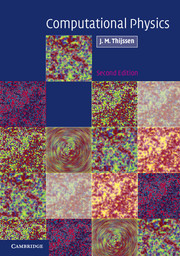Book contents
- Frontmatter
- Contents
- Preface to the first edition
- Preface to the second edition
- 1 Introduction
- 2 Quantum scattering with a spherically symmetric potential
- 3 The variational method for the Schrödinger equation
- 4 The Hartree–Fock method
- 5 Density functional theory
- 6 Solving the Schrödinger equation in periodic solids
- 7 Classical equilibrium statistical mechanics
- 8 Molecular dynamics simulations
- 9 Quantum molecular dynamics
- 10 The Monte Carlo method
- 11 Transfer matrix and diagonalisation of spin chains
- 12 Quantum Monte Carlo methods
- 13 The finite element method for partial differential equations
- 14 The lattice Boltzmann method for fluid dynamics
- 15 Computational methods for lattice field theories
- 16 High performance computing and parallelism
- Appendix A Numerical methods
- Appendix B Random number generators
- Index
8 - Molecular dynamics simulations
Published online by Cambridge University Press: 05 June 2012
- Frontmatter
- Contents
- Preface to the first edition
- Preface to the second edition
- 1 Introduction
- 2 Quantum scattering with a spherically symmetric potential
- 3 The variational method for the Schrödinger equation
- 4 The Hartree–Fock method
- 5 Density functional theory
- 6 Solving the Schrödinger equation in periodic solids
- 7 Classical equilibrium statistical mechanics
- 8 Molecular dynamics simulations
- 9 Quantum molecular dynamics
- 10 The Monte Carlo method
- 11 Transfer matrix and diagonalisation of spin chains
- 12 Quantum Monte Carlo methods
- 13 The finite element method for partial differential equations
- 14 The lattice Boltzmann method for fluid dynamics
- 15 Computational methods for lattice field theories
- 16 High performance computing and parallelism
- Appendix A Numerical methods
- Appendix B Random number generators
- Index
Summary
Introduction
In the previous chapter we saw that the experimental values of physical quantities of a many-particle system can be found as an ensemble average. Experimental systems are so large that it is impossible to determine this ensemble average by summing over all the accessible states in a computer. There exist essentially two methods for determining these physical quantities as statistical averages over a restricted set of states: the molecular dynamics and Monte Carlo methods. Imagine that we have a random sample of, say, 107 configurations of the system which are all compatible with the values of the system parameters. For such a large number we expect averages of physical quantities over the sample to be rather close to the ensemble average. It is unfortunately impossible to generate such a random sample; however, we can generate a sample consisting of a large number of configurations which are determined successively from each other and are hence correlated. This is done in the molecular dynamics and Monte Carlo methods. The latter will be described in Chapter 10.
Molecular dynamics is a widely used method for studying classical many-particle systems. It consists essentially of integrating the equations of motion of the system numerically. It can therefore be viewed as a simulation of the system as it develops over a period of time. The system moves in phase space along its physical trajectory as determined by the equations of motion, whereas in the Monte Carlo method it follows a (directed) random walk.
Information
- Type
- Chapter
- Information
- Computational Physics , pp. 197 - 262Publisher: Cambridge University PressPrint publication year: 2007
